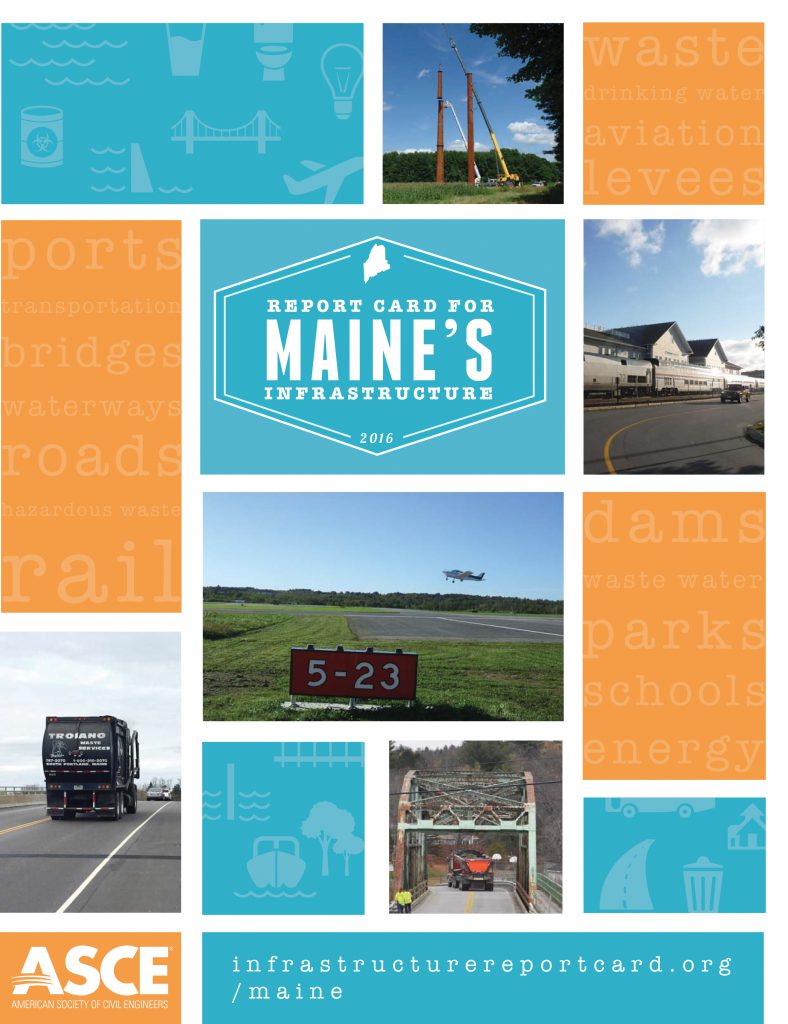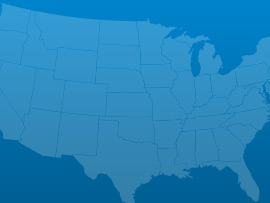 2016 Report Card for Maine's Infrastructure
2016 Report Card for Maine's InfrastructureCivil engineering is a broad field dealing with the planning, design, construction, maintenance and management of infrastructure networks and the resulting safety of the public. Civil engineering includes power plants, electrical distribution, bridges, roads, railways, airports, structures, retaining walls, foundations, water supply & distribution, irrigation, sewer, flood control, waste management, transportation and the protection of the natural environment. The maintenance and improvement of Maine's infrastructure is vital to our economy, health, safety, security, and the environment. Decisions about infrastructure the public uses, which we all pay for through user fees and taxes, as well as private investments, need to be made based on long-term comprehensive planning, with sustainable and reliable funding sources.
As with the national Report Cards produced by ASCE, the purpose of this state Report Card is to raise public awareness of the importance of modern and well-maintained infrastructure. Our infrastructure cannot be taken for granted and requires on-going maintenance and continuous planning. We believe discussion of the issues detailed in this Report Card will lead to a greater understanding of the current and future needs of our state, prompting decision makers in our communities, the state legislature, and our congressional delegation to formulate policies and provide the necessary funding to address our infrastructure needs.
The 2016 Report Card on Maine’s Infrastructure gave the state an overall grade of C-. Maine ASCE analyzed the following fundamental components of each infrastructure area: Existing Conditions, Capacity, Operations & Maintenance, Innovation & Resiliency, Public Safety, and Funding/Investment needs. Of the 14 categories, only two infrastructure categories are in good condition (B-), eight categories ranged in the fair to mediocre range (C+, C or C-), and four categories were considered to be in poor condition (D+ or D). Of more concern are the 8 areas that are showing a decline. The good news is there are solutions to all these challenges, and we can raise Maine’s infrastructure grades.
 Aviation
Aviation Bridges
Bridges Dams
Dams Drinking Water
Drinking Water Education
Education Energy
Energy Environmental Cleanup
Environmental Cleanup Rail
Rail Roads
Roads Solid Waste
Solid Waste Transportation
Transportation Wastewater
WastewaterA: Exceptional, B: Good, C: Mediocre, D: Poor, F: Failing, ?: Incomplete
Each category was evaluated on the basis of capacity, condition, funding, future need, operation and maintenance, public safety, resilience, and innovation
Aviation
35 public-use airports
Bridges
366 of the 2,402 bridges are structurally deficient
Bridges
$29 million in bridge funds came from the Federal Highway Bridge Fund in 2011
Dams
27 high hazard dams
Dams
100% of the state regulated dams have an Emergency Action Plan
Drinking Water
$1.2 billion in drinking water infrastructure needs over the next 20 years
Energy
7.963 gigawatt-hours of renewable energy every year, ranking it 11th
Hazardous Waste
13 sites on the National Priorities List
Inland Waterways
70 miles of inland waterways, ranking it 37th nationally
Levees
3 miles of levees
Ports
15.1 million short tons of cargo in 2012, ranking it 32nd nationally
Public Parks
$38.0 million of unmet needs for its parks system
Rail
7 freight railroads covering 896 miles across the state, ranking 42nd nationally by mileage
Roads
$454.0 million a year in costs to motorists from driving on roads in need of repair, which is $451 /yr per motorist
Roads
2,568 of the state’s 22,871 public roads are major roads, and 7% are in poor condition
Schools
$659.0 million in estimated school infrastructure funding needs
Transit
4.4 million annual unlinked passenger trips via transit systems including bus, transit, and commuter trains
Wastewater
$1.0 billion in wastewater infrastructure needs over the next 20 years

March 03, 2017
As the President’s repeated in his address to Congress his pledge to dramatically increase infrastructure spending to the tune of $1 trillion, various Congressional Committees

March 01, 2017
On Tuesday night, President Trump addressed a joint-session of Congress for the first time in his presidency. Infrastructure was among the many issues he discussed.

February 28, 2017
U.S. motorists set a new record for vehicle miles travelled (VMT) in 2016, driving over 3.2 trillion miles, an increase of 70 billion miles from

February 17, 2017
Romantic dates, the Grammy awards and celebrating black history are not the only milestones of this week; the Oroville dam crisis in California and the